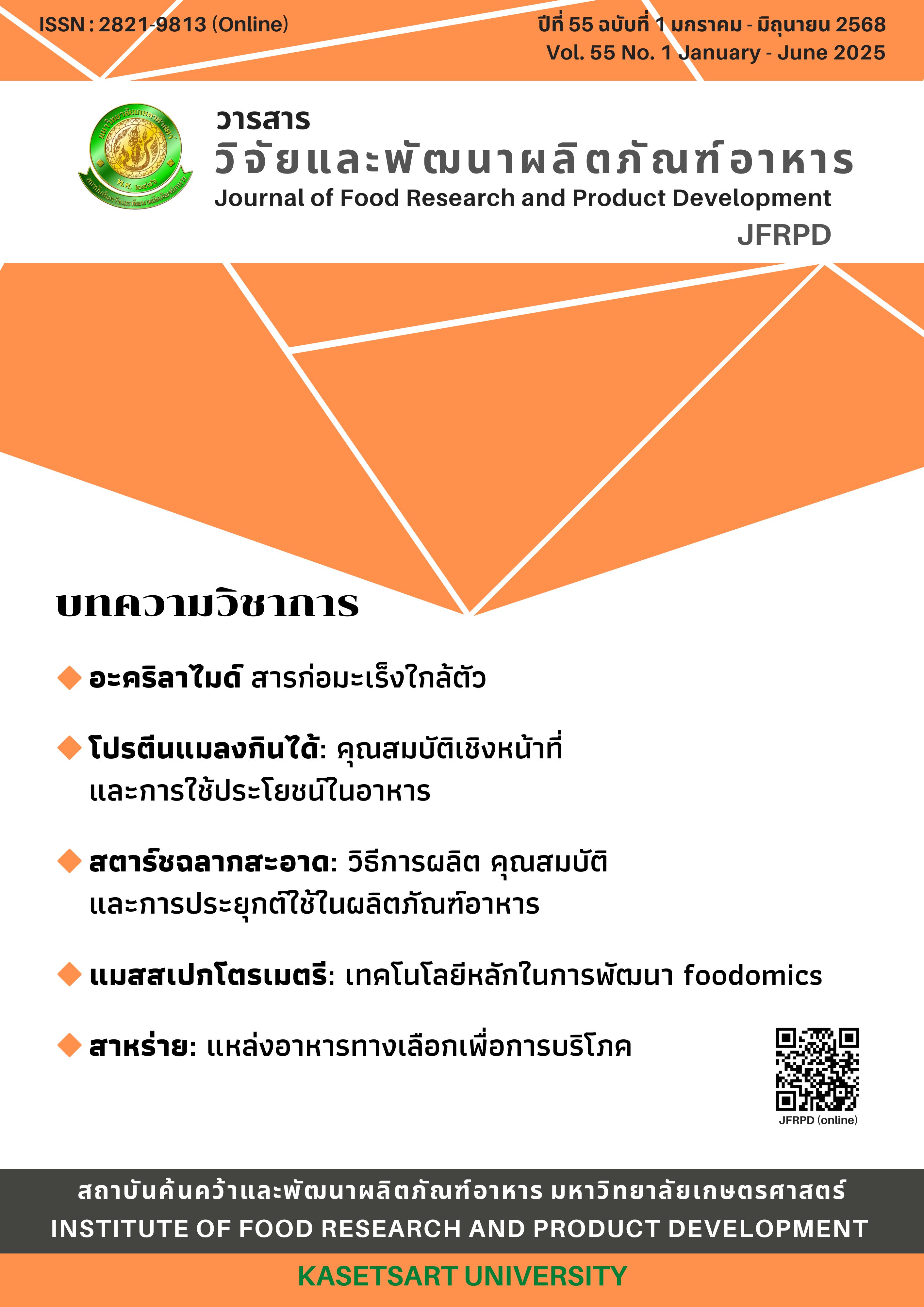แมสสเปกโตรเมตรี: เทคโนโลยีหลักในการพัฒนา foodomics
##plugins.themes.bootstrap3.article.main##
บทคัดย่อ
แมสสเปกโตรเมตรี (mass spectrometry หรือ MS) เป็นเทคโนโลยีที่มีประสิทธิภาพสูงในการวิเคราะห์อาหาร เนื่องด้วยความสามารถในการระบุชนิดของโมเลกุลต่าง ๆ ในอาหารได้อย่างแม่นยำและรวดเร็ว ช่วยให้สามารถเข้าใจองค์ประกอบทางเคมีของอาหารที่ซับซ้อนได้อย่างละเอียดลึกซึ้ง เทคโนโลยี MS นี้มีบทบาทสำคัญในการศึกษาด้านฟู้ดโอมิกส์ ซึ่งเป็นศาสตร์ที่ผสมผสานระหว่างวิทยาศาสตร์อาหาร เคมีและโอมิกส์ เพื่อศึกษาองค์ประกอบทางเคมีระดับโมเลกุลของอาหารและความสัมพันธ์กับคุณภาพ สุขภาพ และความปลอดภัยของอาหาร โดยเทคโนโลยี MS นี้สามารถระบุและหาปริมาณสารเมทาบอไลต์ โปรตีน และสารประกอบอื่น ๆ ในอาหารได้อย่างแม่นยำ นอกจากนี้ยังใช้ตรวจหาสารปนเปื้อนและสารก่อภูมิแพ้ ช่วยพัฒนาผลิตภัณฑ์อาหารที่มีคุณภาพและปลอดภัยมากขึ้น การนำเทคโนโลยี MS มาประยุกต์ใช้ในการวิเคราะห์และวิจัยด้านอาหาร จึงเป็นประโยชน์อย่างยิ่งต่อการพัฒนาผลิตภัณฑ์อาหารเพื่อให้ได้มาซึ่งอาหารที่มีคุณภาพและปลอดภัย ตลอดจนการส่งเสริมสุขภาพของผู้บริโภค ในอนาคตเทคโนโลยี MS ยังคงพัฒนาอย่างต่อเนื่อง และมีบทบาทสำคัญในการวิจัยทางด้านอาหาร ช่วยแก้ไขปัญหาความท้าทายด้านอาหารในอนาคต เช่น การผลิตอาหารที่ยั่งยืน การพัฒนาอาหารเพื่อสุขภาพ และการตรวจสอบคุณภาพอาหารอย่างรวดเร็วและแม่นยำ
##plugins.generic.usageStats.downloads##
##plugins.themes.bootstrap3.article.details##

This work is licensed under a Creative Commons Attribution-NonCommercial-NoDerivatives 4.0 International License.
เอกสารอ้างอิง
Labster. Mass Spectrometer. Available from: https://theory.labster.com/mass-spectrometer
Cifuentes A. Food analysis and foodomics. J Chromatogr A. 2009;1216:7109-7110.
Valdés A, Álvarez RG, Socas RB, Herrero M, Ibáñez E, Cifuentes A. Foodomics: Analytical opportunities and challenges. Anal Chem. 2022;94:366-381.
Zhang, S, Qi X, Naggar Y, Wu L, Wang K. Understanding the gastrointestinal protective effects of polyphenols using foodomics-based approaches. Frontiers in Immunology. 2021;12:671150.
Mozzi F, Ortiz ME, Bleckwedel J, De Vuyst L, Pescuma M. Metabolomics as a tool for the comprehensive understanding of fermented and functional foods with lactic acid bacteria. Food Res Int. 2013;54:1152-1161.
Cevallos J, Corcuera J, Etxeberria E, Danyluk M, Rodrick G. Metabolomic analysis in food science: a review. Trends Food Sci Technol. 2009;20:557-566.
Monton J, Soga T. Metabolome analysis by capillary electrophoresis-mass spectrometry, J Chromatogr A. 2007;1168:237-246.
Geographical origin authentication via elemental fingerprint of food [Internet]. JRC Publications Repository; [cited 2025 Apr 18]. Available from: https://publications.jrc.ec.europa.eu/repository/bitstream/JRC132521/JRC132521_01.pdf
Y. Zhang, "Application of isotope analysis for food authenticity and traceability: Progress and challenges," Master's thesis, University of Virginia, 2015.
Zhao J, Li A, Jin X, Liang G, Pan L. Discrimination of geographical origin of agricultural products from small-scale districts by widely targeted metabolomics with a case study on pinggu peach. Front Nutr. 2022;9:891302. doi: 10.3389/fnut.2022.891302
Hidalgo MJ, Gaiad JE, Goicoechea HC, Mendoza A, Pérez-Rodríguez M, Pellerano RG. Geographical origin identification of mandarin fruits by analyzing fingerprint signatures based on multielemental composition. Food Chem X. 2023;20:101040.
Kussmann M, Fay L. Foodomics: Advanced mass spectrometry in modern food science and nutrition. 2013;167-189.
Gill BD, Saldo SC, McGrail IJ, Wood JE, Indyk HE. Rapid method for the determination of thiamine and pantothenic acid in infant formula and milk-based nutritional products by liquid chromatography‒tandem mass spectrometry. J AOAC Int. 2020;103(3):812–817.
Ross KL, Dalluge JJ. Liquid chromatography/tandem mass spectrometry of glycolytic intermediates: deconvolution of coeluting structural isomers based on unique product ion ratios. Anal Chem. 2009 May 15;81(10):4021-6.
Baniasadi H, Vlahakis C, Hazebroek J, Zhong C, Asiago V. Effect of environment and genotype on commercial maize hybrids using LC/MS-Based metabolomics. J Agric Food Chem. 2014;62(6):1412-1422.
Van den Abbeele P, Poppe J, Deyaert S, Laurie I, Otto Gravert TK, Abrahamsson A, Baudot A, Karnik K, Risso D. Low-no-calorie sweeteners exert marked compound-specific impact on the human gut microbiota ex vivo. Int J Food Sci Nutr. 2023 Sep;74(5):630-644.
Geißler K, Greule M, Schäfer U, et al. Vanilla authenticity control by DNA barcoding and isotope data aggregation. Flavour Fragr J. 2017;32:228–237.

